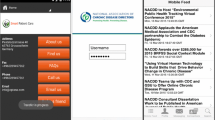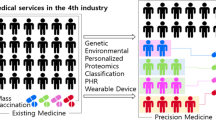Abstract
Due to our rapidly aging society, there has been an increasing need for preventive management of chronic diseases and management of individual health conditions. Among the chronic diseases, diabetes has become one of the most important illnesses in the modern era, and there is an increasing number of diabetes patients in all age groups. With increasing concern for ubiquitous health care services and the developing information technology, there has been a rapid increase in the convenience of preventive management for various types of disease and health conditions. In addition, demand for the management of chronic diseases by using internet of things devices has been increasing. In this study, a personal health record (PHR)-based diabetes index service model is suggested by analyzing lifestyles. For the method suggested in this study, a PHR-based mobile service for users is provided while developing the diabetes index model using lifestyle analysis. By utilizing the Korea National Health and Nutrition Examination Survey provided by the Ministry of Health and Welfare as a fundamental resource, this study analyzes the correlation and differentiation of a non-diabetic group and a diabetic group. For the selection of items in correlation, a multivariate analysis algorithm is used. A PHR related to health behavior and dietary habits in the same pattern is collected from users according to pre-chosen items. The Minkowski distance formula is used for the algorithm for PHR predictive analysis for users and chosen items. Resources on health conditions and dietary habits in the same pattern are collected from users, while calculating similarities among diabetes patients. By using the weight of calculated similarity, a diabetes index is derived. In addition, a management information service for preventing diabetes is offered through derived resources. A mobile application is developed from a smart health care platform to provide services at any time and any place. The mobile application’s interface is configured for users to conveniently enter the PHR and check their health conditions on a real-time basis. It is feasible for each user to check the results from feedback by using the PHR. This quantifies the diabetes index and provides information about desirable health behavior and dietary habits related to diabetes at the same time. Users are able to conveniently apply them in real life with the provided services. Therefore, it is available to improve the health conditions of users and to prevent disease.







Similar content being viewed by others
References
Lee, J. W. (2010). A study on developmental strategy of elderly people’s welfare policy in an aging society. Department of Welfare Administration, the Graduate School of Administration Chung-Ang University.
International Diabetes Federation. http://www.diabetesatlas.org/.
World Health Organization. http://www.who.int/mediacentre/factsheets/fs310/en/.
Jeong, S. M. (2012). Quercetin alleviates hyperglycemia and dyslipidemia in ob/ob mice. Department of Smart Foods and Drugs, Graduate School, Inje University.
Jeon, S. H., & Kim, N. H. (2013). Diabetes risk analysis model with personalized food intake preference. Journal of the Korea Academia-Industrial Cooperation Society, 14(11), 5771–5777.
Kwak, Y. S., Ku, W. Y., Yoo, B. I., Jin, Y. W., Choi, K. S., Cho, J. Y., et al. (2008). Effects of different exercise intensity on excess post exercise oxygen consumption (EPOC), resting metabolic rate (RMR), and biochemical variables in obese and NIDDM patients. Journal of Life Science, 18(10), 1455–1463.
Jung, H., & Chung, K. (2016). PHR based life health index mobile service using decision support model. Wireless Personal Communications, 86(1), 315–332.
Chung, K., & Park, Roy C. (2016). PHR open platform based smart health service using distributed object group framework. Cluster Computing, 19(1), 505–517.
Korea Centers for Disease Control and Prevention (2015). 6th Korean national health and nutrition examinations survey (KNHANES VI-1). Korea centers for disease control and prevention.
Cox, M. E., & Edelman, D. (2009). Tests for screening and diagnosis of type 2 diabetes. Clinical Diabetes, 27(4), 133.
Lim, J. H. (2011). Dietary and lifestyle factors in development and management of diabetes in Korean adults. Seoul National University, The Graduate School.
Cha, G. H. (2009). A similarity ranking algorithm for image databases. Journal of KIISE, 36(5), 366–373.
Jung, H., Chung, K. Y., & Lee, Y. H. (2013). Decision supporting method for chronic disease patients based on mining frequent pattern. Multimedia Tools and Applications, 74(20), 8979–8991.
Park, D., Kim, J., Kim, J., Jung, E., & Lee, Y. (2011). U-Health service model for managing health of chronic patients in multi-platform environment. Journal of the Korea Contents Association, 11(8), 23–32.
Jung, E. Y., Kim, J. H., Chung, K. Y., & Park, D. K. (2014). Mobile healthcare application with EMR interoperability for diabetes patients. Cluster Computing, 17(3), 871–880.
Cem, A., Kamil, E., Mehmet, E. O. (2012). TeleHealth: Intelligent healthcare with M2M communication module. In Proceedings of the ACM workshop on mobile systems, applications, and services for healthcare, no. 7.
Chung, K., Kim, J. C., & Park, R. C. (2016). Knowledge-based health service considering user convenience using hybrid Wi-Fi P2P. Information Technology and Management, 17(1), 67–80.
Jung, H., & Chung, K. (2015). Sequential pattern profiling based bio-detection for smart health service. Cluster Computing, 18(1), 209–219.
Jung, H., & Chung, K. (2016). Knowledge-based dietary nutrition recommendation for obese management. Information Technology and Management, 17(1), 29–42.
Kim, S. H., & Chung, K. Y. (2015). Medical information service system based on human 3D anatomical model. Multimedia Tools and Applications, 74(20), 8939–8950.
Kim, J. H., & Chung, K. Y. (2014). Ontology-based healthcare context information model to implement ubiquitous environment. Multimedia Tools and Applications, 71(2), 873–888.
Oh, S. Y., Ghose, S., Chung, K., Ryu, J. K., & Han, J. S. (2014). Recent trends in convergence-based smart healthcare service. International Journal of Technology and Health Care, 22(3), 303–307.
Jo, S. M., & Chung, K. (2014). Design of access control system for telemedicine secure XML documents. Multimedia Tools and Applications, 74(7), 2257–2271.
HL7. Health level seven international. http://www.hl7.org.
Kim, S. H., & Chung, K. (2015). Emergency situation monitoring service using context motion tracking of chronic disease patients. Cluster Computing, 18(2), 747–759.
Jung, H., & Chung, K. (2016). P2P context awareness based sensibility design recommendation using color and bio-signal analysis. Peer-to-Peer Networking and Applications, 9(3), 546–557.
Jung, H., & Chung, K. (2016). Life style improvement mobile service for high risk chronic disease based on PHR platform. Cluster Computing, 19(2), 967–977.
Acknowledgments
This research was supported by Basic Science Research Program through the National Research Foundation of Korea (NRF) funded by the Ministry of Education (2013R1A1A2059964).
Author information
Authors and Affiliations
Corresponding author
Rights and permissions
About this article
Cite this article
Yoo, H., Chung, K. PHR Based Diabetes Index Service Model Using Life Behavior Analysis. Wireless Pers Commun 93, 161–174 (2017). https://doi.org/10.1007/s11277-016-3715-9
Published:
Issue Date:
DOI: https://doi.org/10.1007/s11277-016-3715-9




